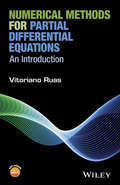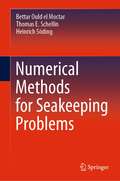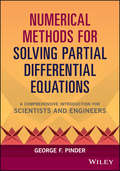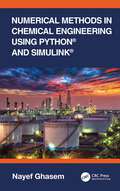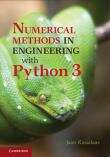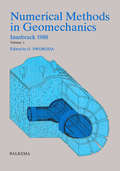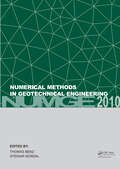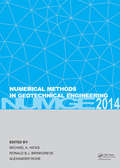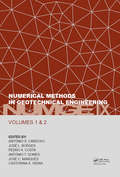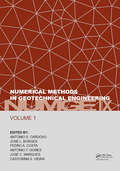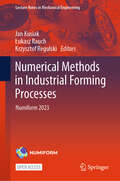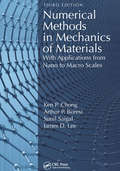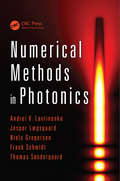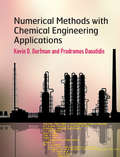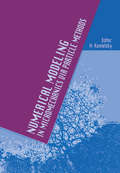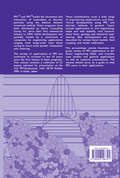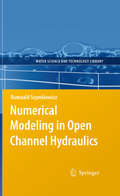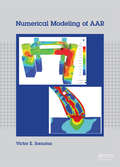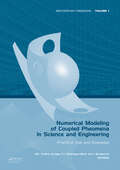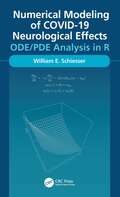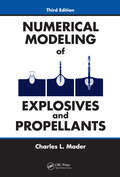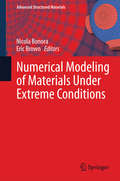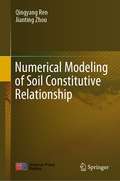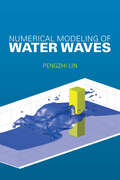- Table View
- List View
Numerical Methods for Partial Differential Equations: An Introduction
by Vitoriano RuasNumerical Methods for Partial Differential Equations: An Introduction Vitoriano Ruas, Sorbonne Universités, UPMC - Université Paris 6, France A comprehensive overview of techniques for the computational solution of PDE'sNumerical Methods for Partial Differential Equations: An Introduction covers the three most popular methods for solving partial differential equations: the finite difference method, the finite element method and the finite volume method. The book combines clear descriptions of the three methods, their reliability, and practical implementation aspects. Justifications for why numerical methods for the main classes of PDE's work or not, or how well they work, are supplied and exemplified. Aimed primarily at students of Engineering, Mathematics, Computer Science, Physics and Chemistry among others this book offers a substantial insight into the principles numerical methods in this class of problems are based upon. The book can also be used as a reference for research work on numerical methods for PDE's.Key features: A balanced emphasis is given to both practical considerations and a rigorous mathematical treatment The reliability analyses for the three methods are carried out in a unified framework and in a structured and visible manner, for the basic types of PDE's Special attention is given to low order methods, as practitioner's overwhelming default options for everyday use New techniques are employed to derive known results, thereby simplifying their proof Supplementary material is available from a companion website.
Numerical Methods for Seakeeping Problems
by Bettar Ould el Moctar Thomas E. Schellin Heinrich SödingThe book describes currently applied and newly developed advanced numerical methods for wave-induced ship motions and loads. Besides well-established computational methods based on strip theory, panel methods and finite volume methods for unsteady Reynolds-averaged Navier-Stokes equations (URANS), recent advances like a fully nonlinear Rankine panel method, URANS calculations including elastic hull deformations, and an improved method to predict added resistance in waves are explained in detail. Furthermore, statistical methods to assess extreme motions and loads are described both for linear and nonlinear responses in a stationary seaway as well as during long-term ship operations. Results of motions and loads, computed using the various methods, are compared with each other and with results of model experiments.Introductory chapters on fluid dynamics, motions of rigid and elastic ship hulls, numerical methods to compute fluid flows associated with wind waves, and the development and simulation of seaways complement the volume. The book will be of interest to post-graduate students, PhD candidates, as well as engineers in the field of naval architecture, ocean, and marine engineering.
Numerical Methods for Solving Partial Differential Equations: A Comprehensive Introduction for Scientists and Engineers
by George F. PinderA comprehensive guide to numerical methods for simulating physical-chemical systems This book offers a systematic, highly accessible presentation of numerical methods used to simulate the behavior of physical-chemical systems. Unlike most books on the subject, it focuses on methodology rather than specific applications. Written for students and professionals across an array of scientific and engineering disciplines and with varying levels of experience with applied mathematics, it provides comprehensive descriptions of numerical methods without requiring an advanced mathematical background. Based on its author’s more than forty years of experience teaching numerical methods to engineering students, Numerical Methods for Solving Partial Differential Equations presents the fundamentals of all of the commonly used numerical methods for solving differential equations at a level appropriate for advanced undergraduates and first-year graduate students in science and engineering. Throughout, elementary examples show how numerical methods are used to solve generic versions of equations that arise in many scientific and engineering disciplines. In writing it, the author took pains to ensure that no assumptions were made about the background discipline of the reader. Covers the spectrum of numerical methods that are used to simulate the behavior of physical-chemical systems that occur in science and engineering Written by a professor of engineering with more than forty years of experience teaching numerical methods to engineers Requires only elementary knowledge of differential equations and matrix algebra to master the material Designed to teach students to understand, appreciate and apply the basic mathematics and equations on which Mathcad and similar commercial software packages are based Comprehensive yet accessible to readers with limited mathematical knowledge, Numerical Methods for Solving Partial Differential Equations is an excellent text for advanced undergraduates and first-year graduate students in the sciences and engineering. It is also a valuable working reference for professionals in engineering, physics, chemistry, computer science, and applied mathematics.
Numerical Methods in Chemical Engineering Using Python® and Simulink®
by Nayef GhasemNumerical methods are vital to the practice of chemical engineering, allowing for the solution of real-world problems. Written in a concise and practical format, this textbook introduces readers to the numerical methods required in the discipline of chemical engineering and enables them to validate their solutions using both Python and Simulink. Introduces numerical methods, followed by the solution of linear and nonlinear algebraic equations. Deals with the numerical integration of a definite function and solves initial and boundary value ordinary differential equations with different orders. Weaves in examples of various numerical methods and validates solutions to each with Python and Simulink graphical programming. Features appendices on how to use Python and Simulink. Aimed at advanced undergraduate and graduate chemical engineering students, as well as practicing chemical engineers, this textbook offers a guide to the use of two of the most widely used programs in the discipline. The textbook features numerous video lectures of applications and a solutions manual for qualifying instructors.
Numerical Methods in Computational Mechanics
by Jamshid Ghaboussi Xiping Steven WuThis book explores the numerical algorithms underpinning modern finite element based computational mechanics software. It covers all the major numerical methods that are used in computational mechanics. It reviews the basic concepts in linear algebra and advanced matrix theory, before covering solution of systems of equations, symmetric eigenvalue solution methods, and direct integration of discrete dynamic equations of motion, illustrated with numerical examples. This book suits a graduate course in mechanics based disciplines, and will help software developers in computational mechanics. Increased understanding of the underlying numerical methods will also help practicing engineers to use the computational mechanics software more effectively.
Numerical Methods in Engineering with Python 3
by Jaan KiusalaasThis book is an introduction to numerical methods for students in engineering. It covers the usual topics found in an engineering course: solution of equations, interpolation and data fitting, solution of differential equations, eigenvalue problems, and optimization. The algorithms are implemented in Python 3, a high-level programming language that rivals MATLAB® in readability and ease of use. All methods include programs showing how the computer code is utilized in the solution of problems. The book is based on Numerical Methods in Engineering with Python, which used Python 2. This new text demonstrates the use of Python 3 and includes an introduction to the Python plotting package Matplotlib. This comprehensive book is enhanced by the addition of numerous examples and problems throughout.
Numerical Methods in Geomechanics Volume 1: Innsbruck, 1988
by G. SwobodaFirst Published in 2017. Routledge is an imprint of Taylor & Francis, an Informa company.
Numerical Methods in Geotechnical Engineering: (NUMGE 2010)
by Thomas BenzNumerical Methods in Geotechnical Engineering contains 153 scientific papers presented at the 7th European Conference on Numerical Methods in Geotechnical Engineering, NUMGE 2010, held at Norwegian University of Science and Technology (NTNU) in Trondheim, Norway, 2 4 June 2010.The contributions cover topics from emerging research to engineering pra
Numerical Methods in Geotechnical Engineering
by Michael A. Hicks Ronald B.J. Brinkgreve Alexander RoheNumerical Methods in Geotechnical Engineering contains the proceedings of the 8th European Conference on Numerical Methods in Geotechnical Engineering (NUMGE 2014, Delft, The Netherlands, 18-20 June 2014). It is the eighth in a series of conferences organised by the European Regional Technical Committee ERTC7 under the auspices of the International
Numerical Methods in Geotechnical Engineering IX: Proceedings of the 9th European Conference on Numerical Methods in Geotechnical Engineering (NUMGE 2018), June 25-27, 2018, Porto, Portugal
by António S. Cardoso, José L. Borges, Pedro A. Costa, António T. Gomes, José C. Marques & Castorina S. VieiraNumerical Methods in Geotechnical Engineering IX contains 204 technical and scientific papers presented at the 9th European Conference on Numerical Methods in Geotechnical Engineering (NUMGE2018, Porto, Portugal, 25—27 June 2018). The papers cover a wide range of topics in the field of computational geotechnics, providing an overview of recent developments on scientific achievements, innovations and engineering applications related to or employing numerical methods. They deal with subjects from emerging research to engineering practice, and are grouped under the following themes: Constitutive modelling and numerical implementation Finite element, discrete element and other numerical methods. Coupling of diverse methods Reliability and probability analysis Large deformation – large strain analysis Artificial intelligence and neural networks Ground flow, thermal and coupled analysis Earthquake engineering, soil dynamics and soil-structure interactions Rock mechanics Application of numerical methods in the context of the Eurocodes Shallow and deep foundations Slopes and cuts Supported excavations and retaining walls Embankments and dams Tunnels and caverns (and pipelines) Ground improvement and reinforcement Offshore geotechnical engineering Propagation of vibrations Following the objectives of previous eight thematic conferences, (1986 Stuttgart, Germany; 1990 Santander, Spain; 1994 Manchester, United Kingdom; 1998 Udine, Italy; 2002 Paris, France; 2006 Graz, Austria; 2010 Trondheim, Norway; 2014 Delft, The Netherlands), Numerical Methods in Geotechnical Engineering IX updates the state-of-the-art regarding the application of numerical methods in geotechnics, both in a scientific perspective and in what concerns its application for solving practical boundary value problems. The book will be much of interest to engineers, academics and professionals involved or interested in Geotechnical Engineering.
Numerical Methods in Geotechnical Engineering IX, Volume 1: Proceedings of the 9th European Conference on Numerical Methods in Geotechnical Engineering (NUMGE 2018), June 25-27, 2018, Porto, Portugal
by José L. Borges António S. Cardoso Pedro A. Costa António T. Gomes José C. Marques Castorina S. VieiraNUMGE 2018 is the ninth in a series of conferences on Numerical Methods in Geotechnical Engineering organized by the ERTC7 under the auspices of the International Society for Soil Mechanics and Geotechnical Engineering (ISSMGE). The first conference was held in 1986 in Stuttgart, Germany and the series continued every four years (1990 Santander, Spain; 1994 Manchester, United Kingdom; 1998 Udine, Italy; 2002 Paris, France; 2006 Graz, Austria; 2010 Trondheim, Norway; 2014 Delft, The Netherlands).The conference provides a forum for exchange of ideas and discussion on topics related to numerical modelling in geotechnical engineering. Both senior and young researchers, as well as scientists and engineers from Europe and overseas, are invited to attend this conference to share and exchange their knowledge and experiences.This work is the first volume of NUMGE 2018.
Numerical Methods in Industrial Forming Processes: Numiform 2023 (Lecture Notes in Mechanical Engineering)
by Jan Kusiak Łukasz Rauch Krzysztof RegulskiThis open access book comprises selected papers presented at the NUMIFORM 2023 conference, where recent developments, innovations and advances in numerical methods for material forming and shaping through plastic deformation were discussed. The conference topics include the broad areas of material behaviour and modelling and its numerical implementation; process modelling (forming, joining, machining, casting, welding/joining and additive manufacturing, etc., of metals, polymers and composites) and its numerical implementation; and conventional and novel methods of forming and joining metals and polymer and composite processing. This book serves as a valuable reference for academicians and industry professionals alike.
Numerical Methods in Mechanics of Materials: With Applications from Nano to Macro Scales
by Ken P. Chong Arthur P. Boresi Sunil Saigal James D. LeeIn the dynamic digital age, the widespread use of computers has transformed engineering and science. A realistic and successful solution of an engineering problem usually begins with an accurate physical model of the problem and a proper understanding of the assumptions employed. With computers and appropriate software we can model and analyze complex physical systems and problems. However, efficient and accurate use of numerical results obtained from computer programs requires considerable background and advanced working knowledge to avoid blunders and the blind acceptance of computer results. This book provides the background and knowledge necessary to avoid these pitfalls, especially the most commonly used numerical methods employed in the solution of physical problems. It offers an in-depth presentation of the numerical methods for scales from nano to macro in nine self-contained chapters with extensive problems and up-to-date references, covering: Trends and new developments in simulation and computation Weighted residuals methods Finite difference methods Finite element methods Finite strip/layer/prism methods Boundary element methods Meshless methods Molecular dynamics Multiphysics problems Multiscale methods
Numerical Methods in Photonics (Optical Sciences and Applications of Light #1)
by Niels Gregersen Andrei V. Lavrinenko Jesper Lægsgaard Frank Schmidt Thomas SøndergaardSimulation and modeling using numerical methods is one of the key instruments in any scientific work. In the field of photonics, a wide range of numerical methods are used for studying both fundamental optics and applications such as design, development, and optimization of photonic components. Modeling is key for developing improved photonic devices and reducing development time and cost. Choosing the appropriate computational method for a photonics modeling problem requires a clear understanding of the pros and cons of the available numerical methods. Numerical Methods in Photonics presents six of the most frequently used methods: FDTD, FDFD, 1+1D nonlinear propagation, modal method, Green’s function, and FEM. After an introductory chapter outlining the basics of Maxwell’s equations, the book includes self-contained chapters that focus on each of the methods. Each method is accompanied by a review of the mathematical principles in which it is based, along with sample scripts, illustrative examples of characteristic problem solving, and exercises. MATLAB® is used throughout the text. This book provides a solid basis to practice writing your own codes. The theoretical formulation is complemented by sets of exercises, which allow you to grasp the essence of the modeling tools.
Numerical Methods with Chemical Engineering Applications
by Kevin D. Dorfman Prodromos DaoutidisDesigned primarily for undergraduates, but also graduates and practitioners, this textbook integrates numerical methods and programming with applications from chemical engineering. Combining mathematical rigor with an informal writing style, it thoroughly introduces the theory underlying numerical methods, its translation into MATLAB programs, and its use for solving realistic problems. Specific topics covered include accuracy, convergence and numerical stability, as well as stiffness and ill-conditioning. MATLAB codes are developed from scratch, and their implementation is explained in detail, all while assuming limited programming knowledge. All scripts employed are downloadable, and built-in MATLAB functions are discussed and contextualised. Numerous examples and homework problems - from simple questions to extended case studies - accompany the text, allowing students to develop a deep appreciation for the range of real chemical engineering problems that can be solved using numerical methods. This is the ideal resource for a single-semester course on numerical methods, as well as other chemical engineering courses taught over multiple semesters.
Numerical Modeling in Micromechanics via Particle Methods: International PFC Symposium, Gelsenkirchen, Germany, 6-8 November 2002
by H. KonietzkyParticle methods have seen increasing use in several engineering and scientific fields, both because of their unique modelling capabilities and the availability of the necessary computational power. This title focuses on their theory and application.
Numerical Modeling in Micromechanics via Particle Methods - 2004: Proceedings of the 2nd International PFC Symposium, Kyoto, Japan, 28-29 October 2004
by Y. Shimizu R. D. Hart P. A. CundallThe variety of applications of PFC has continued to increase in the ten years since the first release of these programs. This volume contains a collection of fifty-two papers selected for presentation at the 2nd PFC Symposium, held 27-29 October 2004, in Kyoto, Japan. These contributions cover a wide range of engineering applications and theoretica
Numerical Modeling in Open Channel Hydraulics
by Romuald SzymkiewiczThis book offers a comprehensive approach to the numerical modeling of open channel flow, based on the author's own research in this field, as well as his experience as a lecturer. It provides the reader with: Coverage of the most important problems of open channel hydraulics, including steady and unsteady flow in a single channel and in a channel network, transport of dissolved substance, transport of energy and more;Unified derivation of the governing equations for all problems, based on the fundamental laws of mass, momentum and energy conservation;Comprehensive presentation of the numerical methods applied in open channel flow modeling, with particular regard to the solution of hyperbolic and parabolic partial differential equations, which govern many important flow and transport processes;Detailed description of the numerical algorithms applied to solve particular problems, with many examples of solutions; Accuracy analysis of the numerical algorithms using the modified equation approach; New insights into numerical solution of some classical problems of open channel hydraulics, e.g. steady varied flow in a channel of arbitrary geometry.In-depth analysis of the simplified flood routing models and their unphysical properties, including a proposition of an alternative Instantaneous Unit Hydrograph, valid for all simplified models.Written in an accessible language, Numerical Modeling in Open Channel Hydraulics contains information useful for higher level undergraduate and postgraduate students of civil and environmental engineering faculties, as well as scientists and practitioners in the field of hydraulic engineering, especially those using existing numerical codes or developing their own ones.
Numerical Modeling of AAR
by Victor SaoumaThis reference book presents the theory and methodology to conduct a finite element assessment of concrete structures subjected to chemically induced volumetric expansion in general and alkali aggregate reaction in particular. It is limited to models developed by the author, and focuses on how to best address a simple question: if a structure suffe
Numerical Modeling of Coupled Phenomena in Science and Engineering: Practical Use and Examples (Multiphysics Modeling)
by M.C. Suárez Arriaga J. Bundschuh F.J. Domínguez-MotaMathematics is a universal language. Differential equations, mathematical modeling, numerical methods and computation form the underlying infrastructure of engineering and the sciences. In this context mathematical modeling is a very powerful tool for studying engineering problems, natural systems and human society. This interdisciplinary book cont
Numerical Modeling of COVID-19 Neurological Effects: ODE/PDE Analysis in R
by William SchiesserCovid-19 is primarily a respiratory disease which results in impaired oxygenation of blood. The O2-deficient blood then moves through the body, and for the study in this book, the focus is on the blood flowing to the brain. The dynamics of blood flow along the brain capillaries and tissue is modeled as systems of ordinary and partial differential equations (ODE/PDEs). The ODE/PDE methodology is presented through a series of examples, 1. A basic one PDE model for O2 concentration in the brain capillary blood. 2. A two PDE model for O2 concentration in the brain capillary blood and in the brain tissue, with O2 transport across the blood brain barrier (BBB). 3. The two model extended to three PDEs to include the brain functional neuron cell density. Cognitive impairment could result from reduced neuron cell density in time and space (in the brain) that follows from lowered O2 concentration (hypoxia). The computer-based implementation of the example models is presented through routines coded (programmed) in R, a quality, open-source scientific computing system that is readily available from the Internet. Formal mathematics is minimized, e.g., no theorems and proofs. Rather, the presentation is through detailed examples that the reader/researcher/analyst can execute on modest computers. The PDE analysis is based on the method of lines (MOL), an established general algorithm for PDEs, implemented with finite differences. The routines are available from a download link so that the example models can be executed without having to first study numerical methods and computer coding. The routines can then be applied to variations and extensions of the blood/brain hypoxia models, such as changes in the ODE/PDE parameters (constants) and form of the model equations.
Numerical Modeling of Explosives and Propellants
by Charles L. MaderMajor advances, both in modeling methods and in the computing power required to make those methods viable, have led to major breakthroughs in our ability to model the performance and vulnerability of explosives and propellants. In addition, the development of proton radiography during the last decade has provided researchers with a major new experimental tool for studying explosive and shock wave physics. Problems that were once considered intractable – such as the generation of water cavities, jets, and stems by explosives and projectiles – have now been solved.Numerical Modeling of Explosives and Propellants, Third Edition provides a complete overview of this rapidly emerging field, covering basic reactive fluid dynamics as well as the latest and most complex methods and findings. It also describes and evaluates Russian contributions to the experimental explosive physics database, which only recently have become available. This book comes with downloadable resources that contain— · FORTRAN and executable computer codes that operate under Microsoft® Windows Vista operating system and the OS X operating system for Apple computers · Windows Vista and MAC compatible movies and PowerPoint presentations for each chapter · Explosive and shock wave databases generated at the Los Alamos National Laboratory and the Russian Federal Nuclear Centers Charles Mader’s three-pronged approach – through text, computer programs, and animations – imparts a thorough understanding of new computational methods and experimental measuring techniques, while also providing the tools to put these methods to effective use.
Numerical Modeling of Materials Under Extreme Conditions
by Nicola Bonora Eric BrownThe book presents twelve state of the art contributions in the field of numerical modeling of materials subjected to large strain, high strain rates, large pressure and high stress triaxialities, organized into two sections. The first part is focused on high strain rate-high pressures such as those occurring in impact dynamics and shock compression related phenomena, dealing with material response identification, advanced modeling incorporating microstructure and damage, stress waves propagation in solids and structures response under impact. The latter part is focused on large strain-low strain rates applications such as those occurring in technological material processing, dealing with microstructure and texture evolution, material response at elevated temperatures, structural behavior under large strain and multi axial state of stress.
Numerical Modeling of Soil Constitutive Relationship
by Qingyang Ren Jianting ZhouThis book adopts numerical method to model soil constitutive relationship while it abandons the traditional idea of looking for plastic potential as the only way to model. Firstly, the triaxial compression tests of expansive soil, sand and clay under different stress paths are introduced; then the elastoplastic constitutive equations of expansive soil, sand and clay under various stress paths are established by numerical modeling method; finally, the constitutive equations are embedded in the finite element program and verified by comparing the finite element calculation results of the triaxial test soil samples with the corresponding test results. The modeling obtains high accuracy.
Numerical Modeling of Water Waves
by Pengzhi LinModelling large-scale wave fields and their interaction with coastal and offshore structures has become much more feasible over the last two decades with increases in computer speeds. Wave modelling can be viewed as an extension of wave theory, a mature and widely published field, applied to practical engineering through the use of computer tools.
